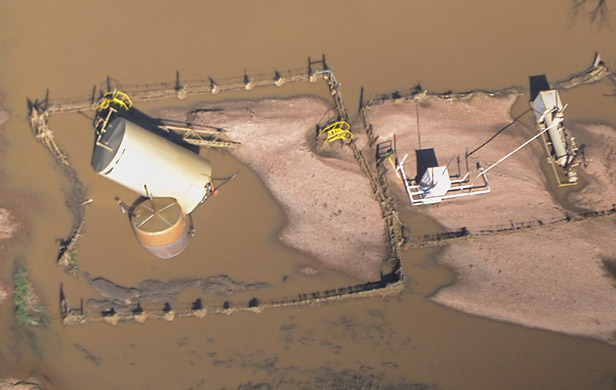
Earlier this week, The Common Sense Canadian brought you the underreported story of flood damage to oil and gas infrastructure in Colorado – featuring photos taken by a local group concerned about toxic chemicals and hydrocarbons leaking into rivers and farmland, in the wake of the state’s catastrophic storm.
Today, we bring you new aerial photos of the wreckage, taken Tuesday over hard-hit Weld County by Colorado conservation photography group EcoFlight.
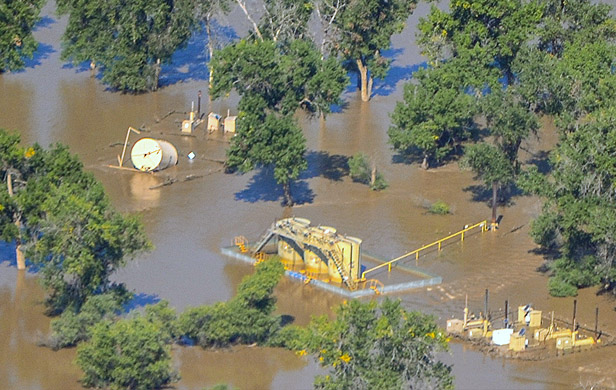
Colorado is one of a dozen or more states that have been part of the controversial “fracking” boom across the United States and around the world. The state’s recent flooding raises the question: should fracking operations be located in a floodplain – especially one with a history of major floods?
Moreover, what oil and gas-related environmental and health impacts are really occurring as a result of this disaster?
Despite the lack of mainstream media coverage of the issue, we do know from the Denver Post of one confirmed pipeline rupture and at least 5,250 gallons of crude oil spilled into the South Platte River from two tank batteries ripped open by the flood.
According to The Post:
[quote]The flood that began late last week toppled dozens of oil and gas storage tanks and swamped other production facilities at sites in the flood plain. Earlier this week, oil drums, some empty, some full, could be seen floating in the river as far east as Kersey.[/quote]
Representatives for the Colorado Oil and Gas Association said Tuesday that nearly 1,900 oil and gas wells in the affected areas have been shut, with industry personnel inspecting and repairing sites.
That does little to reassure Cliff Willmeng of the local anti-fracking group East Boulder County United, who noted earlier this week, “Many of these chemicals are carcinogenic, neurotoxic, and known disruptors of the human endocrine system. As of today there is no testing taking place, industrial, independent or otherwise to determine the extent of the contamination, nor any talk of it.”
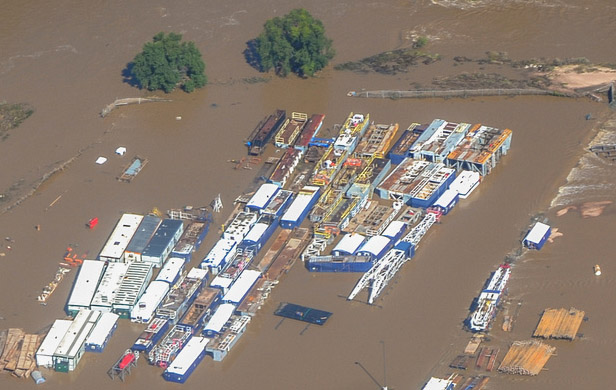
In a follow-up conversation today, Willmeng indicated industry and government authorities have done nothing to allay his concerns:
[quote]What’s perfectly clear here is that the industry is going to act on this disaster in terms of damage control. They’re not prepared to respond to this – they don’t have the labour power, the technical resources or the motivation. This needs to go to higher authorities – the oil and gas industry can’t be the authority on the environmental assessment and remediation of Weld County.[/quote]
A spokesperson for the Colorado Department of Natural Resources, Todd Hartman, downplayed the risks of contamination from open storage pits for toxic frack fluids, noting there are relatively few of these pits in the region of the flood. “We are assessing the impact to open pits, including building a count of how many pits may have been affected,” said Hartman.
Pennsylvania State University petroleum engineering professor Robert Watson also tried to calm the fears of people like Willmeng, telling The Globe and Mail, “The amount of wastewater is so small compared to the amount of water passing through there, and compared to the chemicals used in farming.”
To Willmeng:
[quote]These statements are highly speculative…State authorities don’t even know the scale of the damage yet – nor do they have the people required to properly investigate the situation. What we’re seeing here is a classic game of passing the buck, downplaying the actual damage in an attempt to allay the fears of the public.[/quote]
His organization and others are calling for an immediate statewide moratorium on oil and as activity. In addition, “we’re calling for the Colorado Oil and Gas Commission to end its litigation and harassment of communities protecting themselves by denying oil and gas activity.” The groups have created a petition to this effect.
There are currently five communities in Colorado voting on ballot initiatives to create moratoriums or outright bans of oil and gas activities.
All photos below courtesy of EcoFlight. See more aerial images on their website here.

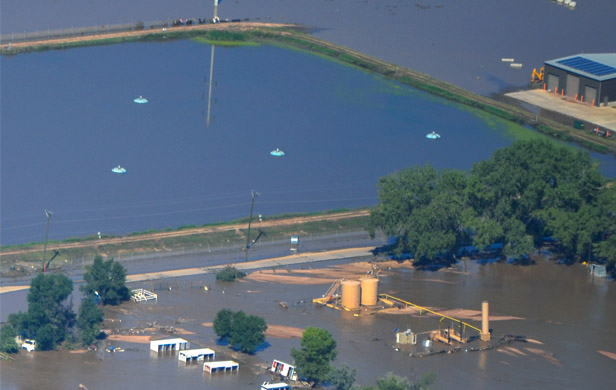
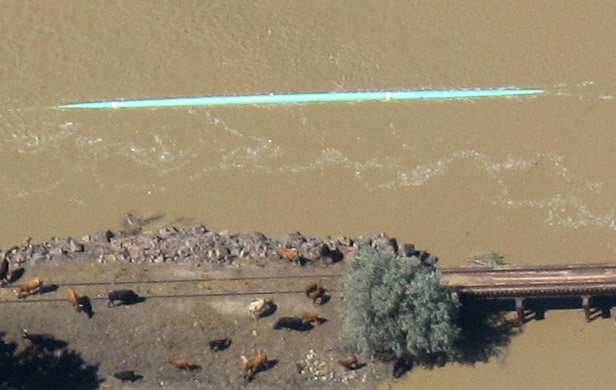
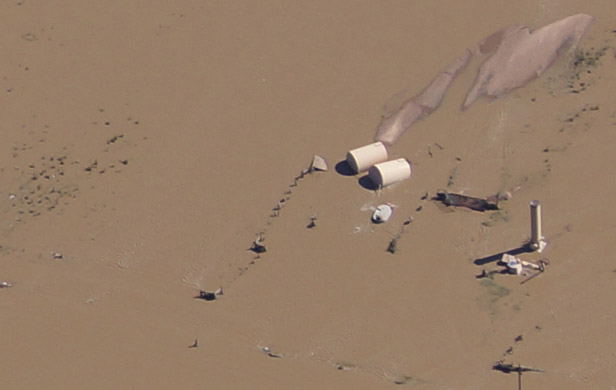
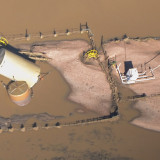

Some really uneducated people posting on the oil and gas industry. Get your facts straight. You may not like the possible pollution effects, but what do you think runs this planet now for energy? I would rather live beside an oil facility than a nuclear plant! And wind/solar power can’t supply the worlds needs at an inexpensive cost. If you don’t use ANY oil based equipment in your home etc. vehicle, heating; then you can complain.
Rick, we are in complete agreement. Much of the world does run on fossil fuels – and we’re all for changing that.
It’s no longer some pie-in-the-sky notion that the world could be powered by cleaner, renewable alternatives.
Renwables are one of the world’s biggest growth sectors today – with China, the US and Europe investing heavily and reaping the rewards of a green economy. Sure, China’s the world’s biggest consumer of fossil fuels, but their growth in renewables is sheerly staggering – and they invested $70 Billion in this sector last year. The growth in their use of coal is slowing and predicted to peak in 2020, which analysts say will spell the beginning of the end of coal as a major fuel source:
https://commonsensecanadian.ca/end-coal/
Unfortunately, in Canada, we’re going in the opposite direction:
https://commonsensecanadian.ca/canada-green-jobs/
One of the primary historical challenges to renewables has been cost relative to fossil fuels. But that’s changing in a big way, with solar now approaching the cost of coal.
http://tinyurl.com/pum4prj
You may point to the proliferation of unconventional oil and gas sources, but costs are rising relative to renewables and they face mounting challenges on the environmental front. Moreover, the decline rates for production of shale oil and gas are proving to be far quicker and steeper than anyone imagined. Many of the big US plays at the forefront of the fracking boom – like the Marcellus Shale – are showing signs of going bust far sooner than the industry banked on:
http://tinyurl.com/py3sbe6
Again, this matters because the trajectory of renewables is cheaper and more available; whereas the long-term trend for fossil fuels is in the other direction. When renewables pass fossil fuels on their upward arc, there will be no argument left for this unhealthy, unsustainable model. The first place to start is ceasing public subsidies to fossil fuels and redirecting those funds toward innovation, renewables, energy efficiency and conservation. Why should the taxpayer give corporate welfare to the richest companies int the world to produce its most dangerous forms of energy?
This is not to say that we don’t have a long, long way to go – nor that some serious changes in our consumerist, energy-intensive way of life in the West won’t be required in a world lass dependent on fossil fuels.
But incidents like this one and the myriad oil spills we see affecting communities and ecosystems around the world – not to mention extreme weather events like the one afflicting Colorado – all serve as powerful reminders for how important this project is.
Again, thank you for pointing this out, Rick. You raise some important questions.
In the first place that’s not a drilling rig. It’s a workover rig. In the second place none of those tanks store fracing fluid. If you’re going to rant and rave you should at least know what you’re talking about otherwise you just look like a fool.
My apologies, Kathy. Workover rig, yes. This from Wikipedia on workovers:
“They are only performed if the completion of a well is terminally unsuitable for the job at hand. The production tubing may have become damaged due to operational factors like corrosion to the point where well integrity is threatened. Downhole components such as tubing, retrievable downhole safety valves, or electrical submersible pumps may have malfunctioned, needing replacement.
That’s so much more reassuring!
Kathy,
You’re right, its not a drilling rig; however, please do not “throw the baby out with the bathwater” (floodwaters). There has been an oil spill-fact. Waste tanks spilled toxics into waters and grounds-fact. Floodwaters do cover thousands of acres of farmlands and wells/city water supplies, and toxics get into your food supply-fact. Floodwaters drain into the aquifer that supplies your drinking/cooking water-fact. The toxics in the ground, waters and ultimately the aquifer, will affect all in the area and we who live down stream. The methane that is bubbling up through the flood waters in CO comes from the opened seams in bedrock-this is from fracking in CO-fact.
Why are you not a bit afraid and protective of your health or your loved ones (children?) being poisoned by these things? Hear no-see no-feel no “evil”? OK, so that’s the “american way”-and that’s why these things happen. Money now and forget who it might hurt later.
Do you know that your own taxes-all of them-support these industries through subsidies? We also pay for any damage they create-they do not-that’s LAW-made by all the politicians the industries have bought.
Time to read up, girl-it’s your Life and your loved ones lives at issue here, not just a rage and rant. UNLESS you simply do not care to know or do your own investigation beyond the idustreial propaganda on the corporate media.
It’s a ‘gas lifting’ rig get your facts straight!
Ok, so what I see here is a typical oil field which has been wiped out by floods. What does this have to do with fracking? Every oil field will have oil and water storage tanks to collect the produced petroleum products and these ones happened to get wiped out in a flood. Could there have been a contingency in place to avoid such a thing? Sure. Still nothing to do with fracking.
Do your homework people! A frack is a specific operation where trucks and equipment move onto a well site to pump large volumes of various fluids (yes, often with hazardous chemical additives) down the well to hydraulically fracture the porous rock which in turn increases permeability (the ability for gas/oil to flow through the rock pores). This operation typically lasts 1-3 days and then the site is cleaned up with little to no evidence of the frac which took place. Most of the chemicals pumped down hole are recovered during the initial flow back of the well and then trucked out to a disposal facility.
So unless this was a flash flood that happened to wipe out a frac while it was in progress (unlikely) then this is just another story about a flood that damaged some oil well facilities.
Michael, all of the development and production you see here is fracking-related. There is a swamped drilling rig in one photo, lots of producing well pads and storage tanks for crude and chemical-laced water. None of this would be here if it wasn’t for Colorado’s shale oil and gas boom.
Moreover, none of it should be located in a floodplain.
What does this have to do with fracking? Everything.
The fracking fluids are stored in tanks for use and disposal tanks for trucking it away-which can be tipped over by floods. Also stored in open large many acre pools treated with dispersants that evaporate the toxics into the air-that you/we breathe.
Mike.
The fracking industry uses known carcinogenic materials in the fracking process. So the tanks, wells and storgae facilities affected by the flooding are polluting the river and land.
We’re not debating whether fracking should be allowed. Its already here. Now the issue is….WHAT , if anything is the govt trying to do to mitigate the damage to the environment during the flood and after the flood.
Unfortunately the Fracking industry has denied that anything about the industry is bad for the environment. (The future holds the truth on THAT issue.). So it appears no one is dealing with the leaks.
‘Problem? What problem?”
i dont know about you but I’d be pretty choked if one of those storage tanks full of goo ended up on my property and leaked everything out…….
speaking of strorage tanks with goo leaking out – check out the graphic on-the-ground photos of this very thing on the Colorado petition page reference above.
http://fractivist.blogspot.ca/2013/09/demand-governor-hickenlooper-enact.html
Scroll down to see, literally, green goop oozing out of one of these cracked tanks on someone’s farm.
Like you say, if that was my property, I’d be none too pleased.
this disaster could not have been planed better well done USA
Ok. What does the flooding have to do with fracking? You can’t blame the oil and gas industry for a natural disaster. From what I can see and from what I’ve read this could’ve been potentially alot worse and it seems to be handled as well as possible considering. I just don’t see the correlation between fracking and this flood. I did not see one piece if frack equipment in any of those pics.
You can blame the companies and state authorities who issued them permits to frack in a major floodplain.
Virtually all of the equipment shown in these pictures relates to oil and gas activities – some of which is leaking…the rest, we really don’t know – and that’s the problem.
Please read my response to Kathy. Apparently you believe what the industry tells you through its media.